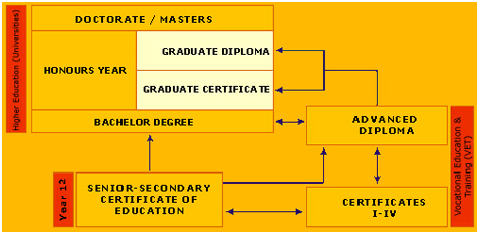AUSTRALIAN EDUCATION SYSTEM
The Australian education system provides primary, secondary and tertiary education.
School education (Primary and Secondary)
School education is similar across all of Australia with only minor variations between states and territories. School education (primary and secondary) is compulsory between the ages of six and sixteen (Year 1 to Year 9 or 10). School education is 13 years and divided into:
- Primary school– Runs for seven or eight years, starting at Kindergarten/Preparatory through to Year 6 or 7.
- Secondary school– Runs for three or four years, from Years 7 to 10 or 8 to 10.
- Senior secondary school– Runs for two years, Years 11 and 12.
Tertiary education
Tertiary education includes both higher education (including universities) and vocational education and training (VET).
Language of instruction
English is the official language of Australia and the main language of instruction in the education system. Many schools offer bilingual programs or programs in other languages.
Australian Qualifications Framework
The Australian education system is distinguished from many other countries by the Australian Qualifications Framework (AQF).(opens in a new window) The AQF was established in 1995 and is a national policy that covers qualifications from the tertiary education sector (higher education and vocational education and training) in addition to the school-leaving certificate; the Senior Secondary Certificate of Education.
The AQF has 10 levels and links school, vocational and university education qualifications into one national system. This allows you to move easily from one level of study to the next, and from one institution to another, as long as you satisfy student visa requirements. It allows for choice and flexibility in career planning. All qualifications in the AQF help prepare you for both further study and your working life.
If you are studying an AQF qualification, you can be sure that your institution is Government-authorised and nationally accredited, and that your degree or other AQF qualification will be genuine.
Our institutions are linked across the country and across the world, which makes it easy to move throughout the education system between courses or institutions and formal agreement and recognition frameworks mean every step of the path will contribute to your future no matter what your study or career goals.

The Australian Qualifications Framework (AQF) establishes the quality of Australian qualifications.
The AQF is the national policy for regulated qualifications in the Australian education and training system. It incorporates the quality assured qualifications from each education and training sector into a single comprehensive national qualifications framework.
The AQF was first introduced in 1995 to underpin the national system of qualifications in Australia encompassing higher education, vocational education and training and schools. The background to the AQF is documented here.
The many AQF stakeholders include industry and its representative bodies, unions, professional associations and licensing authorities and governments. Ultimately students, graduate and employers, both Australian and international, benefit from the quality qualifications that are built on the requirements of the AQF.
In Australia, education and training is a shared responsibility of all Commonwealth, State and Territory governments. Education, training and employment ministers collectively own and are responsible for the AQF.
The AQF provides the standards for Australian qualifications. It is an integrated policy that comprises:
• The learning outcomes for each AQF level and qualification type
• The specifications for the application of the AQF in the accreditation and development of qualifications
• The policy requirements for issuing AQF qualifications
• The policy requirements for qualification linkages and student pathways
• The policy requirements for the registers of:
– organisations authorised to accredit AQF qualifications
– organisations authorised to issue AQF qualifications
– AQF qualifications and qualification pathways
• The policy requirements for the addition or removal of qualification types in the AQF, and
• The definitions of the terminology used in the policy.
The organising framework for the AQF is a taxonomic structure of levels and qualification types each of which is defined by a taxonomy of learning outcomes. The taxonomic approach is designed to enable consistency in the way in which qualifications are described as well as clarity about the differences and relationships between qualification types.
One of the key objectives of the Australian Qualifications Framework is to facilitate pathways to, and through, formal qualifications.
AQF qualifications link with each other in a range of learning pathways between schools, VET and higher education and education and work as an individual’s learning and career ambitions require. The AQF provides for flexible, transparent and systematic learning pathways and to the removal of boundaries between educational sectors.
Verification of AQF qualifications and the organisations authorised to issue them is through the AQF Register.

